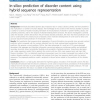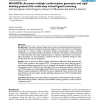16 search results - page 3 / 4 » PROFbval: predict flexible and rigid residues in proteins |
BMCBI
2006
14 years 11 months ago
2006
Background: The structure of proteins may change as a result of the inherent flexibility of some protein regions. We develop and explore probabilistic machine learning methods for...
113
click to vote
BMCBI
2011
14 years 3 months ago
2011
Background: Intrinsically disordered proteins play important roles in various cellular activities and their prevalence was implicated in a number of human diseases. The knowledge ...
BMCBI
2008
14 years 11 months ago
2008
Background: Reliable prediction of antibody, or B-cell, epitopes remains challenging yet highly desirable for the design of vaccines and immunodiagnostics. A correlation between a...
BMCBI
2008
14 years 11 months ago
2008
Background: The number of protein targets with a known or predicted tri-dimensional structure and of drug-like chemical compounds is growing rapidly and so is the need for new the...
BMCBI
2010
14 years 11 months ago
2010
Background: The activity of proteins within the cell is characterized by their motions, flexibility, interactions or even the particularly intriguing case of partially unfolded st...


